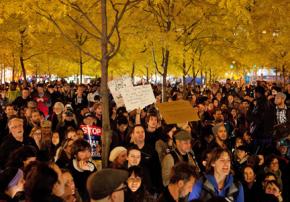Occupy resists the crackdown
rounds up reports from New York City, Berkeley and elsewhere as Occupy activists defend the movement from a coordinated crackdown.
A SPIRITED mass meeting in Manhattan's Zuccotti Park following a police crackdown and a major student strike in Berkeley, Calif., showed the determination of the Occupy movement in the face of police repression and lies from politicians and the corporate media.
In New York, some 1,500 people turned out for a general assembly (GA) meeting less than 24 hours after police in riot gear rousted those camping out in Zuccotti Park, arresting as many as 200 while trashing tents, supplies and even books. It was a meticulously organized, military-style exercise--the flagship operation of coordinated police assaults on Occupy encampments across the U.S.
After a day of protests and a court ruling that the city of New York could ban camping on the site, activists returned to the park to discuss the next steps in the struggle--starting with building for a previously planned day of action on November 17.
"There were about 1,500 people at the GA [general assembly] in the park, and the mood was defiant--even joyful," said Sherry Wolf, an Occupy activist and veteran socialist. "There is a sense of resistance, a feeling that this movement isn't going anywhere. The tone of the GA was to work around the rules banning an encampment."

Wolf was among the hundreds of Occupy supporters who responded to an emergency alert about the police attack on Zuccotti Park at 1 a.m. on November 15. Upon reaching the area half an hour later, she and others were attacked by police with pepper spray and forced out of the area. The activists then marched to nearby Foley Square to hold an impromptu GA for discussing next steps, which included a brief attempt to set up an encampment in another area of lower Manhattan.
For almost the entire day, the NYPD kept Zuccotti Park--renamed Liberty Plaza by protesters--closed, even though a judge initially ordered the city to reverse course. It was only when a higher court ruled in the city's favor that billionaire Mayor Michael Bloomberg ordered cops to let protesters return to the park.
Protesters were told that they could stay in the park 24 hours a day if they chose--but they wouldn't be allowed to take in tents, sleeping bags or tarps. And to enter the park, activists had to pass through metal barricades and a gauntlet of cops, submit to searches and allow themselves to be photographed.
The clear aim of police was to turn what had been a kind of liberated zone into a "protest pen"--the small, barricaded spaces routinely set up by cops to limit protest, and bitterly despised by activists.
But Bloomberg's and the NYPD's attempt at intimidation didn't work. The GA went through its agenda as normal--and hundreds of other activists attended meetings of Occupy Wall Street working groups held just a few blocks away.
According to Jen Roesch, a SocialistWorker.org contributor and Occupy activist:
There's a debate in the movement. Some argue that we can't let Zuccotti be our flagship--that the movement is bigger and deeper than that. They argue that the occupation isn't the most important thing--and that we have to do the work of the movement.
Others point out that Occupy Wall Street is what inspired the movement nationally, what sets the tone. What happened here was part of a coordinated wave of repression--and we have to see what we can do in that context. If we're evicted from the park without te ability to take it back, it will be seen as a setback."
DESPITE THE eviction, Occupy Wall Street still has the capacity to mobilize. For example, Occupy Queens held its first general assembly November 11, attracting some 150 people. Similar efforts are underway in other parts of the city and on college campuses.
The next indicator of Occupy Wall Street's capacity will come on November 17, when a day of action will begin with early morning nonviolent civil disobedience on Wall Street, and culminate in a mass rally at Foley Square near the Brooklyn Bridge by evening.
Big unions--including the Service Employees International Union, Transport Workers Union Local 100 and the United Federation of Teachers--are urging their members to turn out. Labor-aligned community groups are doing likewise. And the informal but huge network of Occupy participants is getting the word out, too.
The unions have also condemned the police crackdown on Zuccotti Park. AFL-CIO President Richard Trumka called the raid "inexcusable," arguing that "Americans must be allowed to speak out against pervasive inequality, even if the truth discomfits the 1 percent." Other unions, including the American Federation of Teachers and the United Auto Workers (UAW) also spoke out against the eviction of the encampment.
The task now is to translate this labor-Occupy alliance into ongoing struggle. One obvious focus in New York City is support for the contract struggles of three groups of workers: bus and subway employees in the TWU and janitors in the SEIU, as well as telephone workers in the Communications Workers of America, who are still battling Verizon after a two-week strike in August ended without an agreement.
Occupy Wall Street's labor committee is already involved in solidarity efforts with these struggles. A win by any one of these unions would be a big boost for labor, which is still being hammered by layoffs and employer demands for concessions.
Then there's the threatened closure of dozens of public schools by Bloomberg's unelected school board--an issue already taken up by the Occupy Wall Street education committee. Struggles against eviction and deportation of immigrants have also been focal points of activism.
The same potential to develop the movement on these and other fronts exists nationally. However, the movement must also deal with the impact of the police repression of the camps and keep up the fight for the right to protest and organize freely.
THE OCCUPY struggle in Berkeley points to how the fight for the right to protest can bring new energy and numbers to ongoing struggles. At a November 15 General Assembly meeting of more than 1,200, some 88 percent voted to reestablish an encampment that had been violently shut down by police some six days earlier.
The crowd later swelled to at least 5,000, and the evening GA transitioned into a teach-in led by a relative of the late Mario Savio, a leader of the 1960s Berkeley Free Speech movement. People read out portions of Savio's famous speech in defense of the right to protest to huge cheers. It was clear from the crowd, which represented activists of two generations, that torch of struggle was being passed.
Another featured speaker was Berkeley professor and former U.S. Secretary of Labor Robert Reich, who spoke on the topic of "Class warfare in America." Reich said, "I will believe corporations are people when Texas and Georgia execute them"--and he spoke about how the poverty and inequality in the U.S. during the 1960s laid the basis for the Free Speech Movement.
While it was unclear if police would once again clear the campus of tents and other occupation supplies, the November 15 mobilization showed that the local student Occupy movement was undeterred. The Berkeley student struggle had been given a big boost in the big November 2 general strike call in neighboring Oakland, an action that shut down the city's ports with a community picket line of thousands of people.
The Oakland protest had been called in response to the near-lethal police violence to clear the Occupy Oakland camp a week earlier. So when Berkeley cops carried out their own crackdown on November 9, students followed Oakland's example and called a strike of their own.
The Berkeley action added a big mobilization to a previously planned week of action against state budget cuts to higher education. Besides challenging police repression and opposing budget cuts, the protest also called for the reinstatement of affirmative action in the UC system.
The November 15 action began with a noontime teach-in. A featured speaker was Robert Slaughter, an African American political science major at nearby Saint Mary's College who was among the 39 people arrested in the November 9 violent police attack on. In prison, Slaughter was separated from other prisoners, accused by cops of being in a gang, held longer than anyone else and banned from the Berkeley campus.
Zack Aslanian-Williams, a Berkeley student and Occupy Cal activist who helped organize the speakout for Slaughter, said it was important to highlight the racist role of police as mayors across the U.S. use cops to crack down on encampments:
The 1 percent and their police counted on their ability to divide and cripple us by singling out activists of color and subjecting them to the most brutal treatment. They expected that we would not rally around them. Today, we proved them wrong by putting issues of racism and police brutality at the front of our movement. I'm excited by the possibility of an intentionally multiracial and anti-racist Occupy movement.
Thousands then poured out of classroom buildings for a 2:30 p.m. march through Berkeley that gathered as many as 5,000 at its peak. Among the protesters were some 500 activists from Occupy Oakland, which continues organizing despite repeated police crackdowns on its encampment.
While the protest was mainly driven by students, labor activists were visible too, especially Berkeley graduate employees, members of United Auto Workers Local 2865. The grad union, along with undergraduate activists, used the student strike and march to build momentum for a protest the next day in San Francisco against the UC system's Board of Regents.
But the regents, recognizing that the Occupy movement had given new strength to the ReFund California coalition's call for mass demonstrations, canceled their meeting.
The regent's attempt to avoid protesters is a victory for the movement, wrote Joshua Brahinsky, recording secretary for the campus union at the University of California Santa Cruz. "The Regents think that by canceling their meeting, they can deny students and workers a voice," he wrote in an e-mail. "But Wall Street and the Regents can't hide from us--we'll be marching through San Francisco's financial district where many of them have offices."
The protesters oppose the so-called "trigger cuts" built into the state budget by Democratic Gov. Jerry Brown and the Democratic majority in both house of the California state legislature in case of declining state revenues. These cuts likely mean an additional $100 million in reduced resources for the UC system on top of the $650 million in cuts the state made in June.
The UC Regents plan to offset these cuts by an 81 percent increase in tuition over the next five years, layoffs for unionized campus employees, and heavier teaching loads for professors and graduate students.
While the Democrats in Sacramento justify the cuts on the basis of the ongoing recession, the reality is that California's 1 percent is awash in cash. In 2010, there were 716,316 families in California with liquid assets greater than $1 million.
Thus, taxing the richest families just 0.1 percent on these assets, or $1,000 each, could make up for the entire UC budget shortfall. Taxing them approximately 4 percent on these assets would bring the state an additional $25 billion to $30 billion, completely closing the budget deficit.
Now the Occupy movement provides California student activists with the possibility of linking their struggle to a wider fight to tax the rich.
"Today, UC Berkeley demonstrated its solidarity with the Occupy movement by striking, marching on banks and exposing the administrations authoritarian modes of operation," said undergraduate student Jonathan Nunez. "Today began the awakening of a social consciousness capable of transforming our society."


